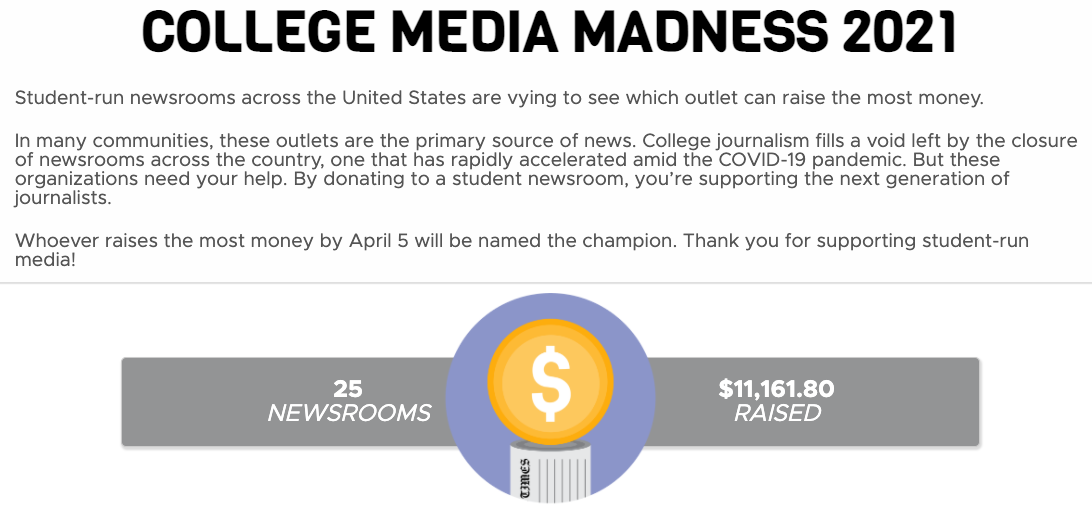March is a storied time for college students to show their school pride and compete with other schools for fame and recognition. Yes, this week is the start of NCAA March Madness. But this year there’s a new challenge: College Media Madness, a fundraising competition for student newspapers around the country.
The premise is simple: Which publication can raise the most money in donations by April 5, when the NCAA men’s basketball tournament ends?
The Daily Orange at Syracuse University spearheaded the competition and organized it in the past month, said fundraising coordinator Haley Robertson.
The Daily Orange has taken a unique approach to financial sustainability and launched a membership program last fall to encourage monthly donations. Other publications have capitalized on rivalries to fundraise, starting with the Daily Tar Heel (University of North Carolina) and the Duke Chronicle (Duke University).
Robertson worked with alumni board members Mark Cooper and Katie McInerney to brainstorm a spring fundraiser. They thought about a bracket-style challenge between student newsrooms, but that would have limited the number of newsrooms that could participate to 16 or 32.
“We had two goals: We want to do this to raise money for the Daily Orange, but also help out other student newsrooms,” Robertson said.
Cooper emailed more than 280 student-run newsrooms around the country, explaining the premise of the competition and inviting them to a Zoom information session. Twenty-five newsrooms ended up participating.
“Some got back to us and said ‘Thanks for thinking of us, we just did a big campaign and the timing isn’t right,’ or they were already doing a rivalry challenge,” Robertson said. “Some schools we ended up with have run fundraising campaigns for years, and for some, this is their first major campaign.”
The only requirement for participating newsrooms was a donation page with visible totals. Each newsroom is asked to report donations daily, and a Google Sheet managed by the Daily Orange feeds into the rankings on the website.
Newsrooms can still join the competition by this Friday, March 19, before midnight Eastern time. They need to send a PNG file of their newsroom’s logo and their donation page link to fundraising@dailyorange.com, and must be willing to update their fundraising totals at least daily.
(Full disclosure: I donated to The Maneater, the independent student newspaper I worked for while at the University of Missouri. This is both a disclosure and an opportunity for me to brag about the fact that they’re currently in second place.)
In less than two days, the competition has raised more than $11,000. McInerney is tweeting updates from @mediamadness21 and keeping an eye on the NCAA’s March Madness account for mentions of schools whose publications are participating.
Robertson said she hopes the challenge will continue in the future, maybe with more structure and a prize for the winner.
“With more planning, I’d love to see a foundation or individual donor who’d give some sort of prize to the winning newsroom, like matching their donations,” she said. “If this keeps going well, that’s a place where it could grow.”
Programming note
I’m taking next week off for a spring break and a few days at a cozy cabin in the Cascade Mountains. The Lead will be back on March 31.
One story worth reading
Socioeconomic barriers limiting access to journalism aren’t just an issue in the U.S. Canadian journalism faces the same issues, from student journalism to professional publications, Tristan Wheeler writes for Passage. “Students who can afford to go to journalism school are getting access to professional networks that will help give them a major advantage over others who couldn’t afford the privilege,” Wheeler writes.
While unpaid internships are illegal in Canada (what a novel thought!) there’s an easy loophole — publications can employ students without pay if they’re providing academic credit. Working at student newspapers for little to no pay exacerbates the same issues.
“The volunteer newsroom is effectively set up to provide space for those who have free time, a luxury often afforded to the rich,” Wheeler writes. “This once again serves to help ensure wealthier students are the ones who get to make it into journalism.”
Opportunities and trainings
- Poynter’s internship database lists paid newsroom internships at publications around the country.
- This public list of journalism conferences tracks what’s coming up, with helpful links and registration deadlines.
- High school students, write an editorial for The New York Times’ contest by April 13.
- Students of color, apply for a fellowship to this summer’s IRE Conference by April 19.
- Apply for the Native American Journalism Fellowship and a scholarship opportunity by April 30.
- Apply for the Asian American Journalists Association’s scholarships or Voices fellowship program.
💌 Last week’s newsletter: Anne Helen Petersen on how student journalists can guard against burnout as they start their careers
📣 I want to hear from you. What would you like to see in the newsletter? Have a cool project to share? Email blatchfordtaylor@gmail.com.






